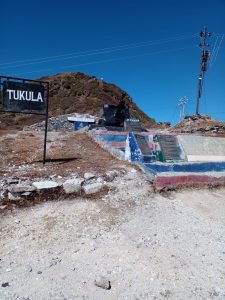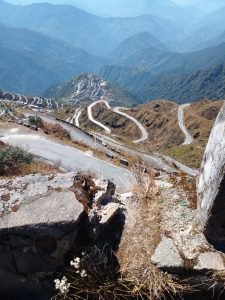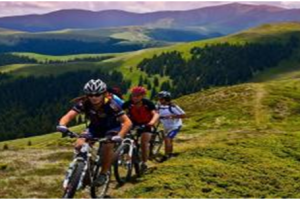
BY NIRMALYA BANERJEE
( FORMER POLITICAL EDITOR, THE TIMES OF INDIA)
GANGTOK | KALIMPONG, 16 DECEMBER 2022
The closed and deserted buildings of the trade mart at Sherthang should leave a visitor to NathuLa wondering what has gone wrong with the border trade between Sikkim and Tibet that started with much promise in 2006.

Even as Kalimpong celebrated the Silk Route Festival spread over five days in the first week of November, 2022, nearly 400 families in Gangtok depending on the border trade across Nathu La are facing difficulties because of the prolonged closure of trade since the lockdown of March 2020.
Besides the traders, nearly 150 drivers ferrying merchandise between Gangtok and the trade marts in Sherathang on the Indian side and Rinchengong on the Chinese side are also facing a loss of income since the closure of the trade. Some of these drivers have now started driving taxis or buses on the mainline passenger routes in Sikkim.
Since the beginning of the border trade across NathuLa in 2006, the first hiccup was in 2017 when trading was closed for 14 days because of the standoff between the armies of India and China at Doklam. In the two subsequent years, trading was normal, before the pandemic intervened early in 2020. The continued suspension of trade even after the improvement in the Covid-19 situation has come as a surprise. It is not known if the continued suspension of border trade is due to China’s emphasis on a “Zero-Covid” policy or because of reasons of security in the aftermath of the Chinese incursions in Ladakh in June 2020. The Doklam situation has also continued to simmer intermittently.

Organizers of the Silk Route Festival in Kalimpong are keen that the old trade route across Jelep La is also reopened for the benefit of the hills of Kalimpong. A drive along the Old Silk Route that traverses the high altitude areas of Sikkim hugging Chumbi Valley in Tibet and the Haa district of Bhutan is a trip down the memory lane; the memory of battles between Tibet and British India, of mule caravans laden with merchandise crossing the JelepLa and NathuLa passes connecting Sikkim with Tibet, of the post-Independence border dispute between India and China culminating in the showdown between the two giant Asian neighbours at Doklam in 2017.

In a way, the name ‘Silk Route’ is a misnomer for this trade route from Kalimpong and Gangtok to Tibet that was opened after the Younghusband expedition to Lhasa in 1903. From the plateau of Tibet, the main merchandise that the mule caravans used to bring down was wool. From Kalimpong, they used to carry up to Tibet mainly manufactured products and food items. But the name has stuck.
The history of the trade route begins in 1884 when the British Indian government started constructing a road to JelepLa with the objective of opening a trade with Tibet. The Tibetans viewed this with suspicion. In 1886 a Tibetan militia, 11,000 – strong, occupied Lungthu and Gnathang. The British army mounted an attack on the Tibetans and between March 15 and September 27, 1888, a series of battles were fought. Though the Tibetan army was numerically stronger, finally the superior fire-power of the British artillery prevailed. Those were the heydays of Kalimpong when trade with Tibet flourished through JelepLa, from the Younghusband expedition to Tibet till the India – China border war of 1962. Kalimpong witnessed a decline in the economic and social life after the closure of the trade route because of the border dispute.

Travellers along the route will come across the war memorial at Tuku La, an important pass at an altitude of about 14,000 feet holding the key to JelepLa, the gateway to Tibet. A Tibetan army occupied the peak on September 18, 1888, but the firepower of the British artillery finally prevailed. A British 25 pounder gun displayed at Tuku La still recalls the memory of the battle.
Travelling along this route, it becomes clear to an interested observer how the pass Jelep La cuts through the high hills of the ChoLa range to provide an easy access to Sikkim and Kalimpong from Chumbi Valley. The valley also abuts the north-western corner of Bhutan at Doklam Plateau, the site of a standoff between the armies of India and the China in 2017.
Doka La, too, is not far from the present alignment of the road; Doka La is on the Indian side of the border overlooking the Doklam Plateau. China contests this, however, and some years ago had dismantled two unmanned observation posts of the India army. A metalled road branches off to Doka La. Civilian vehicles are not allowed to travel on the road, restricted only for use by military vehicles. In fact, all along the route there are army establishments. At some points civilian vehicles are not allowed to stop either.
Among other attractions of the route is a museum set up by the army near Kupup, a short distance from NathuLa gate. Illustrated histories of the ‘Nathu La incident’ and the ‘ChoLa incident,’ a skirmish between the Indian and the Chinese armies using small arms as well as the artillery in 1967, are depicted at the museum. Another is the zig-zag at Zuluk, an engineering marvel. In a series of hairpin bends, the road climbs from an altitude of about 10,000 feet at Zuluk to about 14,000 feet at Gnathang valley. The sight of Kupup Lake, situated at an altitude higher than the more well-known Tsomgo Lake, is also an attraction on this route.
To travel along the Old Silk Route even Indians need a Restricted Area Permit issued by the Sikkim Police that can only be accessed online through registered travel agencies. The road from Gangtok to NathuLa gate is now a four-lane highway, but beyond, between Kupup and Rongli where the restricted area ends, the road is still under construction. One is advised to travel in a vehicle with a high ground clearance. Sedans and hatchbacks can pose problems. Home-stays are available at Zuluk and Gnathang village, but one should acclimatize well before spending the night at the high altitude; to prevent acute mountain sickness.
Advertisement:






























Add Comment